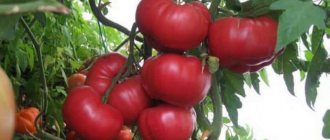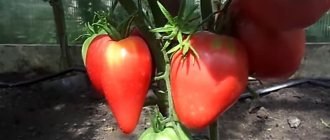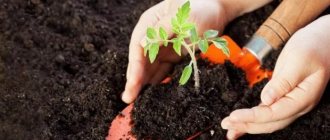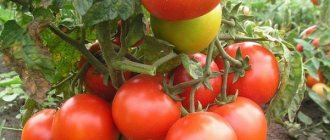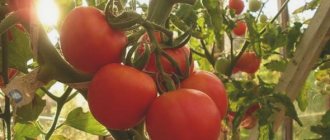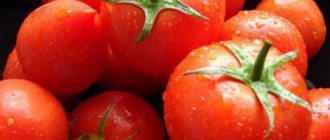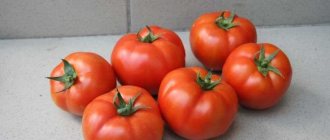Diseases and pests
The Golden Queen tomato is characterized by strong immunity. Resistance is shown to common diseases of nightshade plants. As a preventive measure against tobacco mosaic, late blight, and fusarium wilt, the following measures are recommended:
- disinfect the greenhouse surfaces and soil before planting (use a solution of potassium permanganate or copper sulfate);
- spray the beds with late blight products (copper-containing preparations);
- regularly ventilate the greenhouse, avoiding drafts;
- carry out weeding and loosening of the soil;
- spread a layer of mulch on the ground to protect the soil from drying out.
Plants need to be systematically inspected for pests. The following parasites pose a danger to planting:
- whitefly;
- thrips;
- slugs;
- aphid;
- bear
When insects or their metabolic products are detected, it becomes necessary to spray the beds using insecticides. You can get rid of the Colorado potato beetle by collecting larvae and adults manually. If this does not help, they resort to treating the tomatoes with special means.
Tomato “Korneevsky pink”: description of the variety
| Variety name | Korneevsky pink |
| general description | Mid-season indeterminate variety |
| Originator | Russia |
| Ripening period | 100-110 days |
| Form | Rounded-flattened |
| Color | Pink |
| Average weight of tomatoes | 300-500 grams |
| Application | Dining room |
| Productivity of the variety | up to 6 kg per bush |
| Features of cultivation | Standard agricultural technology |
| Disease resistance | Resistant to major diseases |
The variety is a Russian selection, zoned for all regions. Suitable for growing in greenhouses or film greenhouses, as well as in open beds.
Korneevsky Pink is a mid-season, high-yielding variety. The bush is indeterminate, tall, grows up to 2 m. In closed ground, the plants are taller and spreading; in open beds they turn out to be compact.
The formation of green mass is moderate, the leaves are dark green, medium-sized, simple. 10-12 fruits ripen on the bush; on the lower branches the tomatoes turn out to be larger. The yield is good; from 1 plant you can get up to 6 kg of selected tomatoes.
Among the main advantages of the variety:
- high taste qualities of fruits;
- good yield;
- low maintenance requirements;
- resistance to diseases.
No particular disadvantages were noticed in the variety.
You can compare the yield of this variety with others in the table:
| Variety name | Productivity |
| Korneevsky pink | 6 kg per bush |
| Black Moor | 5 kg per square meter |
| Apples in the snow | 2.5 kg per bush |
| Samara | 11-13 kg per square meter |
| Yablonka Russia | 3-5 kg per bush |
| Valentina | 10-12 kg per square meter |
| Kate | 15 kg per square meter |
| Explosion | 3 kg per bush |
| Raspberry ringing | 18 kg per square meter |
| Yamal | 9-17 kg per square meter |
| Crystal | 9.5-12 kg per square meter |
Description of the Cornet tomato and recommendations for growing it in the garden
Tomato Cornet is recommended to be grown in regions with cool climates. The plant is well adapted to unfavorable climatic conditions. A gardener can see the appearance of the bush and the fruits of the described tomato variety in an agricultural catalog equipped with photographs or in the picture on the package of Cornet tomato seeds. This variety is recommended to be grown under film covers or in open ground.
Characteristics of the variety
The characteristics and description of the variety are as follows:
- The first harvest of Cornet tomato is obtained 85-90 days after seed germination.
- The height of the tomato bush is 0.45-0.5 m. An average number of green leaves develops on the stem.
- Each cluster produces 4 to 5 fruits.
- In an agricultural catalogue, the description of a plant's fruit begins with its shape. Tomatoes look like a ball with a smooth side surface. Ripe fruits are painted in bright shades of red.
- The weight of the fruit ranges from 0.1 to 0.11 kg. The skin and pulp of the Cornet tomato have increased density. There are 4-5 seed chambers inside the fruit.
Reviews from farmers who planted the described variety show that its yield is 3.8-4.2 kg of fruits per 1 m² of bed. Most gardeners grew Cornet in open ground, so the indicated yield figures can be significantly improved if the crop is grown in a greenhouse.
Vegetable growers note the friendly ripening of the plant’s fruits. Due to the early ripening period, Cornet is not susceptible to late blight. As almost all farmers note, the tomato variety described is unpretentious to growing conditions. The bush takes up little space, which allows for maximum compaction of plantings. The density of planting bushes in the beds has virtually no effect on the formation and development of ovaries.
Trading companies willingly buy Cornet from the population, since its fruits can be transported over any distance.
That part of the people who planted Cornet in their garden plots indicates that due to the small growth of the bush, it is not necessary to tie up the stem of the plant or remove the stepsons.
How to grow Cornet in your garden
To obtain the desired harvest, it is recommended to fully comply with all agricultural technology requirements recommended by the tomato developer. To cultivate Cornet, you need to buy tomato seeds in branded stores selling agricultural products.
Seedlings begin to be grown approximately 45-60 days before the planned planting of plants in the ground. The exact time of this operation depends on the place where the gardener lives. Most often this happens at the end of March or mid-April. If the region is characterized by early spring, then the seedlings are grown in greenhouse blocks without heating.
Before planting in pots with soil, seeds are treated with potassium permanganate. They are buried 10-15 mm into the soil. After 2-3 leaves appear on the seedlings, the sprouts dive. A week before transferring the bushes to permanent soil, they are hardened off.
The beds for planting are prepared in advance. To do this, the soil on them is loosened, organic and nitrogen fertilizers are added to the soil. Cornet is planted in a 0.4×0.6 m format. It is recommended to plant 3-4 plants per 1 m² of bed.
If the weather is humid, then cover the bushes with film. The ends of the film coating are left free. For the first 3 days, young plants are protected from sunlight. In order for the bushes to grow together and not get sick, it is necessary to mulch the soil.
During the entire growing season, you should feed the tomatoes 2 times with fertilizers containing nitrogen, potassium and phosphorus.
Watering the bushes is carried out with warm water in the early morning. This requires a moderate amount of liquid. To prevent plants from getting sick, their leaves are treated with the drug Fitosporin. It is recommended to destroy garden pests with chemical poisons.
What are the secrets to successfully growing the Cornet variety?
Firstly, this vegetable responds well to picking. You can safely replant tomatoes, since the root system does not suffer from this. Unlike eggplants, the vegetable does not freeze after picking and quickly recovers.
- Seeds should be planted either directly into the ground or into individual containers for further replanting using the transshipment method, that is, together with the soil, without touching the roots.
- The first step is to prepare a soil mixture at the rate of two parts humus and one part sand, pre-treated with hot water. A few tablespoons of ash are added to the soil.
- In order for the seeds to germinate, they are dipped in warm water for a few minutes, wrapped in cloth and left for 5 days. After the seeds germinate, they are lowered into the prepared soil to a depth of 1 centimeter.
When the first shoots appear, watering is carried out only on the 3rd day. When the young shoots reach a height of ten centimeters, they are transplanted into open ground, with preliminary hardening of the young shoots (2 weeks before planting, the shoots are taken out into the fresh air every day).
Secondly, tomatoes love warm and moist soil. The soil temperature should not be less than 20 degrees Celsius. It is advisable to water the crop in the evening, when the sun has already set and there is no evaporation. The water should be warm and should be watered at the root and every other day.
Another effective way to process crops is mulching. This is best done with grass, straw or sawdust, or a mixture of all.
When mulching a vegetable, one watering per week is enough. If the soil is wet, watering is not performed.
Thirdly, tomatoes are afraid of drafts, winds and closed spaces. They should be planted in a sunny, windless place and fed periodically. For the first time, feed with natural fertilizers, such as mullein or chicken droppings. Then add a handful of ash to the soil every month.
When the plants grow up (reach a height of thirty centimeters), pinching should be done - removing the lower side shoots. During flowering, watering is done every 4 days, weeds are removed and the soil is loosened.
tomato Prince Silver - description and characteristics of the variety
Growing tomatoes Firewood
Proper plant care and compliance with tomato planting rules will help ensure a high yield. The Drova variety does not have any special requirements for breeding. Therefore, seedlings are grown according to the generally accepted algorithm.
Landing rules
Tomato Firewood can be planted as seedlings from mid-February. To do this you need:
- Choose a container of suitable size so that the young shoots are not too crowded.
- It is advisable to disinfect the soil. This can be done by spilling the substrate with a manganese solution, or by calcining the soil in a water bath.
- The seeds also need to be soaked in water with a small amount of potassium permanganate.
- Place the planting material in the ground, lightly sprinkle with earth (no more than 3 mm).
- Humidification should be carried out from a spray bottle.
- To create a greenhouse effect, pots with seeds must be covered with glass or film.
- There is no need to water before the first shoots appear; the tomatoes have enough moisture, which accumulates in the form of condensation.
- When the bushes have 3 leaves, it is necessary to pick the seedlings.
- Planting in open ground should take place no earlier than warm weather outside (at least +15 oC).
- Before planting, seedlings should be hardened by daily exposure to fresh air, increasing the time the plant spends outside each day.
After the bushes move to their permanent place of residence, the seedlings will need to be provided with additional care.
Watering and fertilizing
The description of the tomato variety Drova indicates that the tomato is an unpretentious representative of this crop. However, it still has minimum requirements.
The intensity of watering vegetables depends entirely on the period of tomato development:
- immediately after planting the seedlings in the ground, it must be shed with warm, settled water;
- further watering should be carried out based on the condition of the soil: for example, if mulch was added during planting, it will retain moisture at the roots for a long time, which will help reduce the frequency of watering;
- it is necessary to increase the supply of water at the moment when the tomato begins to bloom and gain fruit. It is forbidden to overwater the vegetable, but the soil should always be slightly moist.
Fertilizers are applied according to the usual scheme:
- during strengthening of seedlings;
- at the moment of flowering;
- during the process of fruit ripening.
Attention! Tomatoes cannot tolerate excess fertilizer, so all fertilizing must be carried out strictly according to the schedule and in the doses indicated on the package
Pinching and tying
Cultivation is carried out in order to distribute the load on the plant and increase the amount of harvest. Drova tomatoes are low-growing, so you can leave 2 - 3 sprouts, which will bear fruit.
Despite their short stature, Drova tomatoes are distinguished by an abundance of fruits. Therefore, it will be difficult for small bushes to hold a large number of tomatoes without proper support. It is recommended to tie the plant when planting seedlings in the ground, so that the young shoots stretch along the support, which is used as wooden stakes, rods, etc.
Formation
Some gardeners advise not to shape the Drova tomato, but do not forget about removing the root shoots. They will consume too much of the plant's vitality, which will negatively affect the quantity of the harvest and the quality of the fruit.
Protection from diseases and pests
Reviews about Drova tomatoes are mostly positive. And many gardeners note that this tomato representative has a good immune system. Thanks to this, many diseases to which nightshades are susceptible are not afraid of it.
In fact, there is no 100% protection against pests and pathologies. Therefore, you need to know how to protect or save a plant from disease.
Late blight: leaves and fruits become brownish. Increased moisture levels contribute to the development of the disease.
Therefore, it is important to follow the watering regime or ventilate greenhouse specimens; Macrosporiasis: formation of dry dark spots on fruits and leaves. Infection can occur from potatoes, so it is not worth planting the crop next to this plant or in its place
Copper oxychloride will help cope with the disease; Anthracnose: The upper leaves of the plant begin to wilt and sunken spots appear on the fruit. The development of the disease can be facilitated by the remains of old plantings, rotted piles of weeds, and even manure piled in the garden. Such remedies as Quadris, Strobi and Flintom can get rid of the problem.
Attention! All diseases are easier to prevent by following the rules for preparing the soil before planting.
Description of the tomato variety German red strawberry, its characteristics and yield
The German red strawberry tomato variety is famous not only for its unusual name. In 2015, reviews from gardeners on forums included it among the ten most popular tomato varieties. This variety from Germany immediately appealed to lovers of unusual, original types of tomatoes. Externally, the vegetables resemble gigantic strawberries. Some gardeners compare the fruits to neat-looking hearts, which once again confirms the unusual shape of the tomato.
The description classifies the plant as an indeterminate species with a medium ripening period; under good weather growing conditions, the ripening period is significantly reduced and the variety can be classified as an early species. The growth of bushes reaches 1.8 meters. Despite the high growth of shoots, the plant is compact. When grown in greenhouse conditions, the shoot height can reach 2.5 meters and the variety shows higher yields.
What are the characteristics of the fruit?
Unusual strawberry-shaped tomatoes can have a rich red or orange tint. The vegetables have an unusual, fruity, slightly sweet taste compared to ordinary tomatoes and an unusually delicate aroma. A distinctive feature is the combination of a sweetish taste with a slight sourness. The outer surface of the vegetables has an unusual glossy shine.
Characteristics and reviews from gardeners note good yield indicators and indicate the possibility of obtaining large-sized fruits. With proper care, the weight of one tomato can reach 300–500 grams, on average it varies from 150 to 300 grams. Vegetables are captivating with their beautiful shape and even coloring of the fruits. In some unripe tomatoes, a small white spot may form at the base of the stalk, which has an increased density and requires cutting when consumed fresh.
The fruits have a low seed content and good fleshiness. Tall bushes, when pinched correctly, are compact, and the plant's brushes contain a large number of ovaries. The variety, in comparison with analogues, is distinguished by early reddening of the fruits.
Depending on climatic conditions, tomatoes can be grown by seedlings or by sowing seeds in the ground.
It is worth paying attention to recommendations for preparing seeds for planting. When independently collecting seeds from a previous harvest, it is recommended to soak the planting material in a stimulating solution for better growth
For such planting material, a preliminary disinfection procedure with hydrogen peroxide or potassium permanganate is recommended. When purchasing ready-made seeds, such work is not required from the manufacturer, since they undergo pre-treatment during the packaging process.
To sow seeds, it is recommended to prepare a mixture of garden or turf soil mixed with humus. For better nutritional value of the shoots, it is worth adding wood ash. To grow seedlings, a temperature of 23–25 ⁰C is required.
Young shoots need sufficient lighting, so to prevent the seedlings from stretching, illumination with a fluorescent lamp is recommended. The first sign of a lack of light is the loss of green color by seedlings. Diving is done after the formation of the first pair of leaves. During this period, it is recommended to carry out the first fertilizing with a mineral complex.
When planting in a permanent place, 3–4 plants are planted per 1 m2. The soil should be loose and generously moistened with humus. It is recommended to pre-treat the soil with a weak solution of manganese.
During the season, shoots are fed 3 to 4 times. Bushes are formed into 1 or 2 stems; the maximum for growing strong stems is the presence of 3 main trunks. The plant needs periodic pinching. It is recommended to remove brushes with deformed and underdeveloped ovaries to stimulate the formation of vegetables and obtain higher yields.
Description of the tomato variety Cornabel - characteristics of the fruit, bush, yield, photo
Tomato intuition is one of the most common tomato varieties among many vegetable growers. It differs from other varieties in its ease of care and high yield. It is believed that this particular tomato variety was the first hybrid bred in our country.
The characteristics and description of the variety will help you understand exactly how it differs from other species.
Intuition tomatoes are mid-season varieties that fully ripen 3-4 months after planting the seedlings. The plant has a fairly tall bush about two meters high. The tomato is an indeterminate plant, which is why it has to be periodically pinched and tied up.
The productivity of tomato intuition is quite high. During the season, more than 35 kg of fruit can be collected on one square meter of land. If a gardener grew a plant in a greenhouse and formed the bushes into one stem, then fertility can increase several times.
The fruits of the plant are dense, round and even. On average, their weight is about 150 grams. Their taste is ordinary, no different from other varieties of tomatoes. If you give the fruits a little more time to ripen, they will become sweeter. Tomatoes are not very large, so they can be used not only for pickling in pieces, but also for whole-fruit canning.
Sowing seeds
Growing any variety of tomatoes begins with planting seeds to obtain seedlings. It is recommended to do this from mid-February to the first of March.
With proper care and feeding, you can get up to 600-700 centners of tubers per hectare.
Description of the Korneevsky tomato, its characteristics and cultivation rules
The Korneevsky tomato is named after the Soviet breeder who registered the variety in the 80s of the last century. These tomatoes are in demand in the food market.
People use them for different purposes: pickles for the winter, salads, lecho, tomato juice, or simply enjoy the wonderful taste of the fruit.
It is worth studying the characteristics and description of the variety in order to get a bountiful harvest of Korneevsky tomatoes.
Description of the Korneevsky tomato
Tomato Korneevsky pink description has the following:
- the plant is mid-season;
- Fruit ripening occurs around mid-summer;
- the height of the bushes reaches 1.3-1.6 m, but there are exceptions - 2 m in height;
- The Korneevsky tomato is unpretentious to the soil, but takes root better in the ground;
- can be grown both in a greenhouse and outdoors;
- in greenhouse conditions, bushes grow smaller than in a garden.
The Korneevsky pink variety has a light crimson color, a sweet taste and an uneven shape resembling a rectangle. 3-4 fruits grow on one cluster, and 3-4 clusters grow on a bush. Accordingly, 9-16 fruits can grow on a bush. The tomatoes are large, weighing up to 400 g. But sometimes there are also giant fruits, reaching 1.5 kg.
The leaves of Korneevsky pink tomatoes are light green in color, smooth on one side and with fluff on the other. Simple inflorescences and a strong root stalk complete the description of the Korneevsky pink tomato. Bushes can have 1-2 trunks (root stalks); double roots are encouraged, since large fruits on the lower clusters often cause stems and stalks to break.
The Korneevsky variety is indeterminate, that is, tall. Bushes and shoots develop without limiting their growth to inflorescences.
After the bushes reach a height of 50-70 cm, the branches are tied up, since in the future they may not support the weight of the fruit.
The Korneev memory tomato has its own fruit characteristics. A single bush can grow up to 16 tomatoes weighing 300-500 g each. Sometimes the weight reaches 1 kg or more. Such fruits are located on the lower branches of the bushes.
The Korneevsky rectangular tomato has a flattened shape at the poles; corners can often be seen. The skin of the fruit is tender, thin, does not crack in the sun, has a light crimson color and a glossy shine.
The fleshy pulp has an amazing sweet taste without sourness. Contains a small amount of seeds in the chamber. The fruits store and ripen well if picked green.
Properties of the Korneevsky pink variety:
- Mid-season. The ripening speed from planting in the ground to red fruits is 100-110 days.
- Large fruits on lower branches can damage the root system and break the stem, so the bushes should be tied to a level wooden support.
- High yield of tomatoes - about 8 kg of crop can be harvested from 1 bush.
- This variety is frost-resistant, so it is planted in the northern regions of Russia. The Korneevsky variety grows well both in greenhouses and in open ground. Unpretentious to soil.
- According to reviews from gardeners, this variety of tomatoes is immune to certain types of pests and plant diseases.
It has its pros and cons. The advantages include higher yields, immunity to pests and diseases such as late blight.
The disadvantages include the fact that sprouted seeds can be planted in the ground 30-60 days after planting, and large fruits must be tied up.
The peculiarities of growing a tomato are not complicated. It is recommended to plant seeds in late March-early April. Seedlings need to be picked only after 1-2 true leaves appear. Photos and reviews from gardeners can be found on the Internet on tomato growing sites.
How to grow Korneevsky tomato?
Planting in open ground occurs in early June. If a gardener decides to arrange greenhouse conditions for the plants, he can plant them at the end of May. The unpretentious variety of Korneevsky pink tomato is afraid of heavy frosts.
When planting in the ground, you must maintain the required distance between the bushes. The distance after weeding should give the bushes additional breathing. The planting pattern in the garden bed is 30x40 cm.
As for pests, it is best to spray the plants in advance so that there are no insects and diseases such as late blight and blossom end rot do not develop from the constant moisture of the bushes.
Plants must be fed with organic and inorganic fertilizers. Organic matter includes compost, manure, etc. Inorganic - fertilizers containing micro- and macrominerals (potassium, copper and others). To eliminate diseases, you can treat tomatoes with a special composition. To do this, dilute 1 tbsp in 1 liter of water. l. hydrogen peroxide and spray the bushes.
Tomato Cornabel: characteristics and description of the variety, photo
Tomatoes similar in shape to plums will not surprise anyone.
Have you ever seen a tomato that is shaped like a pepper? The original hybrid “Cornabel F1” of the famous French one looks like this! This variety was recently acquired on our market, but has already earned many positive reviews and for those interested in the new product, we offer a detailed description of this unusual tomato in all respects, also known as “Dulce”.
Description of the variety
Cornabelle is suitable for lovers of undefined tomatoes; it is for this variety that it is a hybrid.
For those who do not know, we will explain that such tomatoes do not stop growing throughout the season; accordingly, they grow quite tall and need the formation of a bush and a binding garter. But the fruit is so fleshy, with a developed root system of the bush, you can collect much more.
The most unusual thing about Dulce tomatoes is perhaps their shape. They really do look a lot like bright red bell peppers, the resemblance is amazing! The fruits reach 15 cm in length and weigh about 200 g, but sometimes more. The tomatoes are formed into beautiful brushes of 4-7 pieces, while they are the same size, which is very convenient when harvesting.
The fruit also has the following properties:
- The pulp is very juicy, fleshy and sweet, the taste is excellent.
- In this case, the fruits are almost as dense as peppers, thanks to which they tolerate transportation well and are well preserved.
- According to the ripening conditions, Cornabel is a medium-sized tomato, which means that its fruits can be sufficiently absorbed by solar energy and acquire a bright taste (in fact, as you know, ultra-early tomatoes are almost tasteless).
- From the moment the seedlings are planted in the soil for the first harvest, it takes on average about two months.
Among the many advantages of a hybrid, the following should be highlighted:
- high yields even under unfavorable external conditions;
- unusual appearance and the same regular shape of tomatoes;
- excellent taste;
- a long fruiting period distinguishes this tomato from determinate varieties;
- resistance to major diseases and pests, in particular to tomato mosaic, Fusarium wilt, Verticillium wilt;
- good tolerance and fruiting.
The agricultural technology for growing the Cornabel hybrid is determined by its belonging to an undefined tomato. This type of tomato can be grown both in open ground and in greenhouses.
Seeds, as already mentioned, each time you need to buy them in specialized stores.
Tomato seeds can be stored without losing germination for five to six years, and according to the date indicated on the package as the final expiration date, you can usually add a year or even two without fear (a self-respecting manufacturer will always make a reserve for reinsurance).
Planting seeds for seedlings begins a maximum of two months before the planned planting in open ground. For example, for residents of the central belt, you can start this process in mid-March. Indeterminate tomatoes begin to be sown a week or two earlier than standard ones, but overgrown seedlings are always not very good (it is better to plant the seedlings in open ground before they begin to bloom).
Planting in a greenhouse
When the seedlings have formed 1-2 leaves, a selection is made - transplantation into separate containers.
Typically this period begins in May, but certain adjustments are possible for different climate zones. In greenhouses, conditions suitable for transplantation are created approximately a month and a half ago.
After planting the bush, the painstaking work of shaping it begins, and even before that you have to worry about creating reliable supports for tall tomatoes.
It should also be borne in mind that constant pruning and passaging inevitably leads to an increased risk of hives from various infections that penetrate into “open wounds”.
This method produces a slightly smaller crop, but requires minimal effort and is therefore suitable for non-commercial cultivation. Among the features of the agricultural technology of the Dulce tomato, it is also worth mentioning the mandatory top dressing:
- nitrogen, increase green mass;
- potassium to accelerate fruit development;
- phosphorus to strengthen the root system.
An excess of potassium is dangerous for tomatoes of this variety. Firstly, this leads to an excessive increase in the mass of the fruit, which may be inaccessible to the bush itself; secondly, it interferes with the absorption of calcium by the plant, which enters its organs from the soil along with water.
To summarize, the Cornabel tomato deserves the highest rating. Don't forget to plant a few bushes of this French hybrid in your garden, and that will be enough for the whole family to enjoy plenty of sweet, peppery tomatoes throughout the summer and, in addition, provide yourself with a good supply of a delicious vitamin-rich snack for the winter!
Tomato Torquay F1 - description and characteristics of the variety
Torquay F1 belongs to determinant plants. Reaching a certain height (in this case, 70-100 centimeters), its rise practically stops. Belongs to the mid-early tomato species. From the moment the sprouts appear until they mature, it takes about four months.
A distinctive feature of the variety is its high resistance to bad climatic conditions and good protection from diseases.
Suitable for preparing salads, tomato paste, juices and whole fruit canning.
Characteristics
Drought-resistant class. The bush is standard-shaped, with narrow and short foliage, predominantly light green in color. A simple glass. A large number of fruit clusters are formed. Each plant produces 5 or more tomatoes.
An adult plant has a strong root system and stem. These qualities allow the tomato to withstand gusts of wind without any problems, and to get a good harvest when planted in soil with a lack of nutrients and high acidity.
Female tomatoes are medium-sized, rich red in color, weighing 50-80 grams, 5-7 centimeters long. The stamp is cylindrical, with an extension at the tip of the fruit. The configuration vaguely resembles a Bulgarian boy. The skin is glossy, thin, but dense. Inside there are 2-3 chambers with cream-colored seeds.
The bitterness is pleasant, with barely noticeable sourness. Productivity – 4.5 kilograms per square meter. The conclusion of storage without freezing is about two weeks.
A distinctive feature of Torquay F1 can be considered a significant amount of lycopene. Thanks to this property, tomato is useful for people with cardiovascular diseases and oncology.
Features of cultivation
It is important to remember that the future harvest directly depends on the quality of the seed. It is better to plant movra in March in warm, slightly compacted soil, to a depth of one centimeter. It would be a good idea to mulch the soil. It is recommended to water only with warm water. Cover the containers with sprouts with polyethylene and place them in a room with a temperature of approximately 23-25 degrees.
When the first shoots appear, remove the film and bring the plant to a lighted place
At this stage, it is very important to maintain the following temperature conditions:
- In the first week - 15 degrees.
- Then, before planting seedlings in open ground or a greenhouse - 20-22 degrees.
The picking is done near the appearance of the first two leaves. The seedlings are transferred to a permanent location in the session from early to mid-May.
The tomato is easy to care for. In order to achieve decent fruiting, it is enough to carry out a number of activities:
- Water as needed (twice a week in the evening is enough).
- Sometimes loosen the rows to provide oxygen access to the root system (2-3 one day a week).
- Carry out pinching in a timely manner (the most optimal number of stems is 2-3).
- Weed the beds (helps in the fight against diseases, pests, and soil depletion).
- Transform) into (life three-phase feeding of the plant with useful substances:
- 14 days after planting the seedlings, complex fertilizer is applied.
- In the formation of ovaries, phosphorus-potassium mixtures are used.
- When the first tomatoes appear, phosphorus and potash fertilizers are used.
It must be remembered that the wrong dosage can lead to an increase in nitrates, soil contamination, disruption of the growth processes of tomatoes, and at least to their irreversible death.
If the above methods of care are followed accurately, even a novice gardener can hope for a decent result.
Advantages
The undoubted advantages of the variety include:
- Excellent yield.
- Fruiting takes a long time.
- High temperature resistance.
- Good taste.
- High mobility.
- Long shelf life.
- Protection from a large number of diseases.
- Artlessness in care.
Diseases and pests
Tomato Torquay F1 is immune to diseases such as:
- Verticillium wilt.
- Parasporosis.
- Fusarium.
- Stem and root foulbrood.
During the growing season, the plant is susceptible to late blight, which can destroy the entire future harvest. The method of struggle is treatment with Bordeaux mixture, in other words, copper sulfate.
As for pests, we can confidently say that the variety tolerates the presence of nematodes in the soil well, but is only slightly protected from the invasion of aphids and whiteflies. A single use of insecticides (for example, Actellik or Aktara) can help in the fight against them.
Tomatoes and their varieties
Red, yellow, purple, black, green, orange, striped and even two-colored... They come in different colors, and choosing the best variety of tomatoes for yourself can be difficult. Firstly, the variety of varieties is amazing.
Secondly, the choice must be made based on the conditions in which the plants will grow: greenhouse, open ground, shade or sunny area.
Thirdly, both determinate and indeterminate varieties need to be planted on the site to ensure maximum yield.
Determinate and indeterminate tomatoes and their characteristics
Summer residents and owners of personal plots rarely use these words. Determinate plants have a limited growth point, which means they do not grow tall. But indeterminate tomatoes are taller and require more attention in care. They need to be tied up, pinched and provided with the proper conditions for growth.
If tall tomatoes grow better in greenhouse conditions, then low-growing ones can be planted in open ground and used for greenhouses. The list of low-growing varieties is large, so you can choose different types of tomatoes.
Indeterminate varieties of tomatoes during one season (if grown in heated greenhouses, they produce about 40-50 bunches). If the plants are in ordinary greenhouses in the country, then the number of tassels rarely exceeds 30 tassels.
In the southern regions, tall varieties can be planted in open ground. If your summer is cold and short, then it would be better to minimize the planting of tall varieties.
They harvest later and in the northern regions do not always have time to ripen.
Determinate tomatoes have lower yields, but they ripen faster. Most varieties require tying and shaping. If you do not have time for care, then preference should be given to standard varieties. This is one of the varieties of determinate tomatoes with a short, strong stem. They don't need any tying or shaping.
Amazing tomato tree
Every year about 2,000 people come to the tomato tree. This is a tomato variety Sprut F1. The advertisement says that the plant produces about 14,000 tomatoes per year. One of these trees grows in China.
It requires constant care and temperature and intensive fertilizing, has reached a height of 4 meters and has been growing for several years.
But in dacha conditions, almost no one managed to achieve such results
Cherry tomatoes: a little hit in the gardens of summer residents
When it’s time to clean out greenhouses or greenhouses, clear the beds of plants, many gardeners wonder: where to put the Cherry tomato bushes? The fact is that a significant part of the varieties are suitable for growing in pots, and after transplanting they can bear fruit until the New Year.
The cherry-shaped hybrids Cherry Lykopa, Lisa, Kira, Ira, Maksik and some others are ideal for growing. The peculiarity of the fruits is that they are perfectly preserved and can last for more than a month. And at the same time they will not deteriorate and will not even begin to rot! And the Cherry Kira hybrid can be stored for about 2.5 months. For this reason, sellers and summer residents like it so much.
Cherry Lisa tomatoes can be safely planted in a pot and grown on a windowsill.
Cherry tomatoes should be collected and stored using trusses. This will preserve the taste and aromas of the fruit. By the way, Cherry can also be used as an ornamental plant.
You can plant them in ordinary buckets - the volume will be enough to grow a full-fledged bush.
Tomato growing technology
Our technology for growing tomatoes of different varieties is as follows. On our plot we allocate 6 long rows for tomatoes (including closed soil). On three of them, representatives of the best varieties of tomatoes, proven over the years, are grown (there are also tomatoes to choose from), guaranteeing a harvest according to the declared characteristics (regardless of the “delights” of the weather), and the other three are planted with new varieties, which are “considered” this way and that in during the above time. That seems to be it.
No, no, it is very important in the process of experimentation, to accept the starting position in the garden, to consult with employees of many wholesale warehouses and, especially, stores that sell seeds. They know exactly which varieties of tomatoes people understand best, and which ones they swear at! And now I am announcing the number of tomatoes tested in growing, presented below for your viewing, which can still be called the best - 60 varieties
And now I am announcing the number of tomatoes tested in growing, presented below for your viewing, which can still be called the best - 60 varieties.
PS The results were recorded in an area that: with a good warm season, corresponds to the Central Black Earth region (region), and with a bad warm season, corresponds to the North-Western region. Naturally, this range of latitudes in which the above regions are located definitely includes Siberia, the Moscow region, the Middle Zone, the Urals, the Far East, and then figure out for yourself where exactly the paths lead to your site.
My favorite tomato varieties - Vegetable Garden || Tomato cornet characteristics and description of the variety
The best varieties of tomatoes
There are must-have varieties that I always plant every year. I like them not only for their taste and unpretentiousness, but also for the way they look on the bush. I’ll paraphrase one bearded joke: “I don’t really like tomatoes... But the process itself...”. I love going into the greenhouse and admiring the tomato plantations. And I don’t hesitate to show off my particularly spectacular huge tomatoes to my neighbors, and then post photos on the forum. It’s a shame to hide it – we all love it!
Features of cultivation, planting and care
Sowing the seeds of this variety of tomatoes for seedlings is carried out 60-65 days before the intended planting in the ground. Seedlings dive at the stage of two true leaves. When planting seedlings in a permanent place per 1 sq. per meter of plot, up to 3 plants are placed, when formed into 1 stem - up to 4.
Further care for tomatoes consists of timely watering, pinching, fertilizing with complex mineral fertilizer and preventive measures to protect the crop from diseases and pests.
For other interesting varieties with photos, descriptions and reviews, see our Tomato Catalog alphabetically. Enjoy watching!
If you grew tomatoes of the Altai pink variety, please write whether you liked them or not. What was the yield and taste of the fruits like under your climatic conditions? How do you rate the disease resistance of this tomato? If possible, attach a photo of the entire bush or individual fruits you grew.
Your reviews of the Altai pink tomato, as well as additions to the description, will help many gardeners evaluate this variety more objectively and decide whether it is worth planting or not.
This is a natural variety of tomato. Therefore, we recommend taking seeds from a ripe fruit and using them for planting in subsequent seasons.
